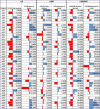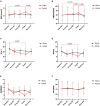Modulation of the autonomic nervous system by one session of spinal low-level laser therapy in patients with chronic colonic motility dysfunction
- PMID: 36117615
- PMCID: PMC9477245
- DOI: 10.3389/fnins.2022.882602
Modulation of the autonomic nervous system by one session of spinal low-level laser therapy in patients with chronic colonic motility dysfunction
Abstract
Patients with a defecation disorder may not evoke a normal defecation reflex, or the reflex may be excessive, as a dysfunction of the spinal autonomic nervous system. Treatment with various forms of lumbar and sacral neuromodulation have shown symptom improvement, but potential changes in autonomic functioning are rarely studied. Here we evaluate the effects on autonomic function of a single session of low-level laser therapy (LLLT) on the lumbar and sacral spine in 41 patients with chronic gastrointestinal motor dysfunction. The LLLT protocol used red LED light at a wavelength of 660 nm for 10 min and infrared LED light at a wavelength of 840 nm for 10 min, followed by infrared laser light at a wavelength of 825 nm for 10 min. Effects on the autonomic nervous system were assessed by measuring heart rate variability (HRV) changes. Respiratory Sinus Arrhythmia (RSA) and Root Mean Square of Successive Differences (RMSSD) were used to quantify parasympathetic reactivity; the Baevsky's Stress Index (SI) reflected sympathetic activity while the ratios SI/RSA and SI/RMSSD were used to show shifts in autonomic dominance. The results indicate that lumbar and sacral neuromodulation using light arrays reduced, whereas stimulation by the laser probes significantly increased parasympathetic activity. The light arrays increased whereas the laser probes significantly decreased sympathetic activity (SI). The entire protocol shifted the autonomic balance toward parasympathetic activity. The comparison of actual vs. sham neuromodulation proved that the change in HRV parameters was due to actual light stimulation and not due to the arrays and probe touching the skin. In conclusion, a single session of LLLT markedly affects autonomic nervous system activity reflected in changes in HRV which is only possible by generating activity in the spinal autonomic nerves. These results warrant a study into the effects of LLLT on restoring autonomic dysfunction in chronic refractory colonic motility disorders.
Keywords: Baevsky stress index; autonomic nervous system; constipation; low level laser (light) therapy (LLLT); respiratory sinus arrhythmia; sacral neuromodulation.
Copyright © 2022 Ali, Saha, Milkova, Liu, Sharma, Huizinga and Chen.
Conflict of interest statement
The authors declare that the research was conducted in the absence of any commercial or financial relationships that could be construed as a potential conflict of interest.
Figures






Similar articles
-
Roles of Heart Rate Variability in Assessing Autonomic Nervous System in Functional Gastrointestinal Disorders: A Systematic Review.Diagnostics (Basel). 2023 Jan 12;13(2):293. doi: 10.3390/diagnostics13020293. Diagnostics (Basel). 2023. PMID: 36673103 Free PMC article. Review.
-
Optimizing Autonomic Function Analysis via Heart Rate Variability Associated With Motor Activity of the Human Colon.Front Physiol. 2021 Jun 29;12:619722. doi: 10.3389/fphys.2021.619722. eCollection 2021. Front Physiol. 2021. PMID: 34267670 Free PMC article.
-
Associations Between Colonic Motor Patterns and Autonomic Nervous System Activity Assessed by High-Resolution Manometry and Concurrent Heart Rate Variability.Front Neurosci. 2020 Jan 23;13:1447. doi: 10.3389/fnins.2019.01447. eCollection 2019. Front Neurosci. 2020. PMID: 32038145 Free PMC article.
-
Determining autonomic sympathetic tone and reactivity using Baevsky's stress index.Am J Physiol Regul Integr Comp Physiol. 2025 May 1;328(5):R562-R577. doi: 10.1152/ajpregu.00243.2024. Epub 2025 Feb 27. Am J Physiol Regul Integr Comp Physiol. 2025. PMID: 40013894
-
[Heart rate variability. Applications in psychiatry].Encephale. 2009 Oct;35(5):423-8. doi: 10.1016/j.encep.2008.06.016. Epub 2008 Dec 18. Encephale. 2009. PMID: 19853714 Review. French.
Cited by
-
COVID-19-induced gastrointestinal autonomic dysfunction: A systematic review.World J Clin Cases. 2023 Aug 6;11(22):5252-5272. doi: 10.12998/wjcc.v11.i22.5252. World J Clin Cases. 2023. PMID: 37621592 Free PMC article.
-
Electromechanical coupling across the gastroduodenal junction.Acta Physiol (Oxf). 2025 Mar;241(3):e70008. doi: 10.1111/apha.70008. Acta Physiol (Oxf). 2025. PMID: 39976325 Free PMC article. Review.
-
Roles of Heart Rate Variability in Assessing Autonomic Nervous System in Functional Gastrointestinal Disorders: A Systematic Review.Diagnostics (Basel). 2023 Jan 12;13(2):293. doi: 10.3390/diagnostics13020293. Diagnostics (Basel). 2023. PMID: 36673103 Free PMC article. Review.
References
-
- Andreo L., Soldera C. B., Ribeiro B. G., de Matos P. R. V., Bussadori S. K., Fernandes K. P. S., et al. (2017). Effects of photobiomodulation on experimental models of peripheral nerve injury. Lasers Med. Sci. 32 2155–2165. - PubMed
-
- Baevsky R. M., Chernikova A. G. (2017). Heart rate variability analysis: Physiological foundations and main methods. Cardiometry 10 66–76. 10.12710/cardiometry.2017.6676 - DOI
LinkOut - more resources
Full Text Sources
Medical

